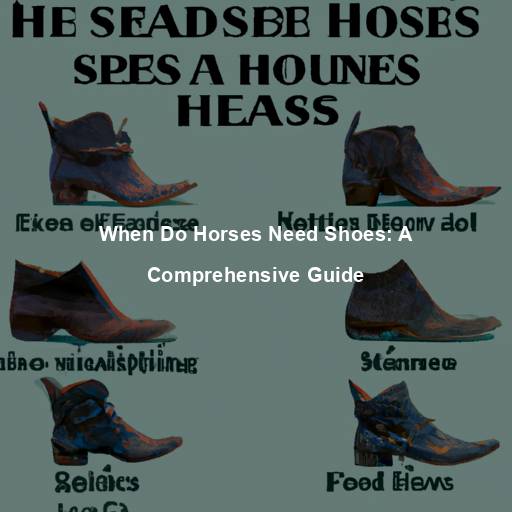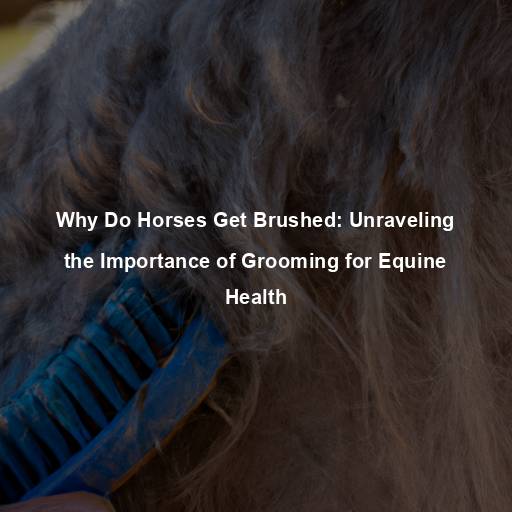When Do Horses Need Shoes: A Comprehensive Guide
Last Updated on November 3, 2023 by Evan
Contents [hide]
- 1 Understanding the Purpose of Horseshoes
- 2 The Natural State of Hooves
- 3 Factors Influencing the Need for Horseshoes
- 4 Consulting with a Farrier
- 5 The Importance of Monitoring and Adaptation
- 6 Alternatives to Traditional Horseshoes
- 7 Caring for Shod Horses
- 8 The Benefits of a Team Approach
- 9 FAQs – When do horses need shoes?
Understanding the Purpose of Horseshoes
Horseshoes have been an integral part of equine care for centuries, serving a crucial role in protecting the hooves of horses. The primary purpose of horseshoes is to provide support, traction, and protection to the horse’s hooves, which are vulnerable to wear and damage. Horseshoes are typically made of metal and are fitted around the hoof to prevent excessive wear, provide grip on different terrains, and distribute the weight of the horse evenly. However, not all horses require shoes, and understanding when and why they are necessary is vital for responsible horse owners.
The Natural State of Hooves
The magnificent hooves of horses captivate with their remarkable resilience and adaptability, perfectly suited to conquer any terrain they traverse. These sturdy structures continuously grow, effortlessly adjusting to the demands of their environment, ensuring their impeccable form withstands the test of time. In their pristine natural state, horses can confidently roam without the need for artificial aids. Yet, there are instances where the inclusion of horseshoes becomes a necessity, offering an extra layer of safeguarding and assistance, when external factors pose a threat to their delicate hooves’ well-being.
Factors Influencing the Need for Horseshoes
When it comes to hoof health, the decision to shoe or not to shoe can be quite a perplexing conundrum. While some of these majestic creatures can comfortably trot along without any footwear, there are certain circumstances that may burst any hopes of a shoeless existence. Factors such as hoof quality, workload demands, and environmental conditions must be meticulously examined to ascertain the necessity of horseshoes. So, take a moment to delve into the intricate world of equine pedicures and uncover the enigmatic truth behind when horses truly need the clink of metal against their hooves.
Terrain and Activity Level
When it comes to our equine companions, the ground beneath their hooves is more than just a surface – it’s a determining factor in their need for the ever-fashionable horseshoes. For those majestic creatures gallivanting through rugged and abrasive landscapes, these metal wonders serve as a shield against wear and tear, sparing them from potential harm. And let’s not forget our high-performance athletes, those daredevil jumpers, racers, and sports enthusiasts. Horseshoes become their trusty companions, providing the much-needed stability and grip that propels them to greatness.
Hoof Quality and Sensitivity
Horses, like humans, come in various shapes and sizes, and their hooves are no exception. Some equines are blessed with naturally supple hooves, delicate in nature yet susceptible to the harsh realities of wear and tear. For these majestic beings, the solution comes in the form of protective shoes that shield their hooves from the unforgiving impact of rugged terrain. Moreover, certain horses, with hooves more sensitive than a delicate melody, or grappling with the burden of hoof maladies like laminitis or navicular syndrome, may find solace in specialized shoeing techniques or therapeutic footwear, calling upon relief and restoration for their aching soles.
Conformational Issues
Horses with conformational abnormalities or imbalances in their limbs may require corrective shoeing to improve their overall gait and posture. Certain conditions, such as collapsed or underrun heels, can be addressed through the use of specific shoeing techniques. Properly fitted horseshoes can help align and support the limbs, reducing strain on joints and tendons.
Intensity of Workload
The well-being of a horse’s hooves can be profoundly affected by the demands placed upon them. These demands vary greatly, with some horses engaging in laborious tasks day in and day out, while others compete in rigorous disciplines that demand peak performance. For these horses, the addition of horseshoes can provide invaluable support and cushioning, minimizing the strain imposed on their hooves. By regularly shoeing these hardworking equines, the risk of injuries stemming from repetitive impacts can be significantly reduced.
Consulting with a Farrier
Deciding on whether your beloved equine companion requires a stylish pair of shoes or can roam freely without them can be an enigma wrapped in perplexity. Seeking the counsel of a learned farrier, a true connoisseur of equine hoof arts, is paramount in unraveling this mysterious dilemma. These adept artisans possess a rare gift for evaluating the individualistic needs of each horse, thoughtfully considering factors such as physique, occupational demands, hoof excellence, and overall well-being, thereby navigating the labyrinthine path to the ideal shoeing or trimming solution.
Selecting the Right Farrier
When it comes to the hoof health of your beloved equine companion, the choice of a farrier is of utmost importance. With a myriad of options out there, it can feel like navigating through a perplexing maze. However, fret not, as we have a burst of wisdom to share. Opt for a seasoned farrier, one who wears their certification like a badge of honor and boasts a reputation that echoes through the equine kingdom.
Regular Hoof Maintenance
Whether your horse requires shoes or not, regular hoof maintenance is crucial. This includes routine trimming to maintain proper hoof balance and prevent overgrowth. Regular cleaning and inspection can help identify any signs of injury, infection, or hoof-related issues that require immediate attention. Additionally, providing a suitable environment for your horse, such as clean and dry turnout areas, can contribute to overall hoof health.
The Importance of Monitoring and Adaptation
Even after determining that your horse needs shoes, it is essential to monitor their hooves regularly and adapt the shoeing approach as needed. Hoof growth, environmental changes, and alterations in workload can all impact the effectiveness of the shoeing. Regular consultations with your farrier will ensure that your horse’s shoeing needs are continually met, allowing for adjustments and modifications when necessary.
Horseshoes are needed for all horses.
It’s an intriguing misconception that all horses must trot around with horseshoes clacking beneath their hooves. Surprisingly, equines aren’t an exclusive club when it comes to donning these metal accessories. The decision to equip a horse with horseshoes largely depends on an intricate interplay of variables – the jagged terrain they traverse, the resilience of their hooves, and the demands placed on them. So, let’s delve into these entangled narratives and explore the enigmatic realm of horseshoes, where mystery and practicality intermingle.
Horseshoes make hooves weaker.
There is a common misconception that horseshoes weaken the hooves of horses. However, when properly fitted and maintained, horseshoes do not weaken the hooves. In fact, they can help protect the hooves from excessive wear and damage, especially on abrasive surfaces. Regular hoof care, including trimming and cleaning, is essential for maintaining healthy hooves, whether the horse wears shoes or not.
Horseshoes are a permanent solution.
Horseshoes are not a permanent solution and may need to be adjusted or replaced regularly. The growth of the horse’s hooves requires periodic trimming and reshaping of the shoes to ensure a proper fit. Additionally, the type of shoes used may vary based on the horse’s needs and any changes in its workload or hoof condition.
Horseshoes prevent all hoof problems.
When it comes to horseshoes, it’s no secret that they offer a sense of support and safeguard for those precious hooves. However, it’s important to realize that they are not the magical cure-all for every hoof woe. Don’t be deceived by their shiny appearance, as regular vigilance, upkeep, and adopting appropriate hoof care techniques remain vital in combating those pesky hoof problems. Don’t fret though, as trusty farriers are always at your beck and call, ready to lend their expertise in preserving hoof health and spotting potential issues long before they morph into full-blown crises.
Alternatives to Traditional Horseshoes
While traditional horseshoes have been widely used for centuries, there are alternative options available for horse owners to consider. These alternatives aim to provide similar benefits while addressing specific concerns or preferences.
Hoof Boots
Hoof boots are a popular alternative to traditional horseshoes. These boots are designed to be worn over the horse’s hooves, providing protection, support, and traction. Hoof boots come in various styles and offer customizable features to suit different terrains and activities. They can be an excellent choice for horses that require temporary protection or for those whose hooves are not suitable for traditional shoeing.
Glue-On Shoes
Looking for an alternative to traditional horseshoes that will leave you and your horse feeling like they’re walking on air? Say hello to glue-on shoes! These innovative hoof accessories offer all the benefits of their conventional counterparts, but with a twist – they’re attached using adhesive materials instead of pesky nails or metal fittings. Not only do they provide the much-needed support, protection, and enhanced traction for your equine companion, but they also allow for natural hoof movement, making it a win-win situation.
Barefoot Trimming
When it comes to caring for our equine companions, the concept of barefoot trimming has emerged as a thought-provoking alternative. By embracing this method, we embark on a perplexing journey of regular hoof maintenance and trimming, an act that strives to retain the natural essence and perfect equilibrium of our horse’s hooves. The overarching goal of this technique is to enhance hoof functionality, fortitude, and overall well-being. Consequently, it becomes paramount to enlist the guidance of seasoned barefoot trimmers or knowledgeable farriers to navigate the intricate world of hoof care.
Caring for Shod Horses
If your horse requires shoes, it is essential to be proactive in their care to ensure their ongoing well-being. Here are some key considerations for caring for shod horses:
Regular Shoe Maintenance
Keeping your horse’s shoes in top-notch condition is absolutely essential for their overall well-being and optimal performance. That’s why it’s vital to schedule regular visits from a skilled farrier who can expertly assess the fit of the shoes, make any necessary tweaks, and swiftly replace worn-out ones. By prioritizing routine shoe maintenance, you can significantly minimize the risk of uncomfortable looseness or poorly fitted shoes, ultimately safeguarding your horse’s precious hooves from potentially harmful damage.
Hoof Hygiene
Ensuring impeccable hoof hygiene is an absolute imperative for horses wearing shoes. Regularly tending to the hooves allows for the eradication of pesky dirt, stubborn debris, and sneaky moisture that tend to take refuge between the hoof and the shoe. It is of utmost importance to conscientiously examine the hooves on a frequent basis, on the lookout for any alarming signs of infection, the uninvited guest known as thrush, or any other perplexing issues that might demand immediate intervention.
Monitoring Hoof Health
Ensuring the well-being of your equine companion entails keeping a vigilant eye on the condition of their hooves. Staying attuned to subtle cues like hoof sensitivity, uncharacteristic limping, or alterations in their majestic gait can prove crucial. In the event you witness any peculiarities or anxieties, it behooves you to seek guidance from a trusted farrier or veterinarian, whose expertise will navigate you through the labyrinth of equine hoof health with finesse.
Adjusting Shoeing as Needed
When it comes to our four-legged companions, like horses, catering to their ever-changing needs is imperative. To ensure optimum well-being, it is crucial to engage in open conversations with your trusted farrier regarding alterations in workload or hoof condition. By doing so, they can expertly assess if adjustments to the shoeing approach are required, which may entail opting for different shoe types or modifying the shoeing schedule itself. Embrace this holistic approach to equine care for a harmonious partnership with your majestic steed!
Regular Trimming
Regular trimming is necessary to maintain the optimal shape and balance of the hooves. Trimming should be done by a qualified farrier or trimmer who understands the natural anatomy of the hoof and can address any imbalances or abnormalities. Trimming intervals may vary depending on individual hoof growth rates and environmental factors.
Balanced Diet and Nutrition
A balanced diet is crucial for overall equine health, including hoof health. Providing horses with a diet that meets their nutritional needs, including essential vitamins and minerals, can contribute to strong, healthy hooves. Consult with a veterinarian or equine nutritionist to ensure your horse’s diet supports optimal hoof growth and strength.
Regular Exercise and Movement
We all know that exercise is a crucial part of maintaining hoof health, but have you ever wondered why? Well, let me burst that bubble of perplexity for you. When our equine friends get moving, their blood starts flowing, and that increased circulation is like a booster shot for their hooves, promoting hearty horn growth like nothing else. And here’s the kicker – exercising on different types of terrain actually helps build strong and functional hooves, making our noble steeds ready to conquer any terrain.
Hydration and Moisture Control
Ensuring the delicate balance of hydration and moisture in hooves is absolutely vital for their overall health. When hooves become excessively dry or overly saturated, a perplexing whirlwind of problems can arise, from brittleness to softness, making them more vulnerable to potential harm and infections. By diligently offering hygienic, dry bedding within stalls and closely observing outdoor conditions, one can navigate the intricate dance of maintaining ideal moisture levels for hooves with a certain finesse and determination.
Regular Inspection and Cleaning
Ensuring the utmost hoof health and well-being is an imperative task that demands meticulous attention. By diligently examining and tidying the hooves on a regular basis, one can prevent any lurking troubles from escalating into severe afflictions. Vigilantly removing any unwanted elements or interlopers from these precious appendages is crucial, guarding against potential infections and discomfort. Furthermore, an astute observation of the hooves’ condition, thoroughly scrutinizing for any hints of injury, fractures, or anomalous symptoms, warrants speedy resolutions to any potential issues that may arise.
Environmental Considerations
Ensuring your horse’s hoof health takes center stage, cultivating a conducive environment becomes paramount. Steer clear of muddy or excessively wet terrains, as it can weaken hoof structure and heighten susceptibility to unwelcome infections. By offering well-drained turnout spaces and pristine stables, you proactively nurture an environment that favors robust hooves and overall equine well-being.
The Benefits of a Team Approach
Taking care of your horse’s hooves requires a synchronized effort from a diverse group of equine specialists. These experts, each playing a crucial role in maintaining your horse‘s hooves, form the intricate puzzle that ensures your horse’s well-being. Allow me to shed light on some of the pivotal members that make up this fascinating hoof care team, offering a glimpse into their unique contributions and the collective puzzle they assemble to keep your equine companion happy and sound.
Farrier or Trimmer
Ensuring the well-being of your horse’s hooves requires the expertise of a highly skilled farrier or trimmer. Their invaluable role in maintaining the balance and health of those precious hooves is not to be taken lightly. Regular engagements with these proficient professionals are imperative, as they possess the knowledge and abilities to trim, shoe, and address any specific concerns that may arise. By openly communicating your horse’s needs and aspirations, you can work together to formulate a well-suited hoof care regimen, dispelling any uncertainties that may linger.
Veterinarian
Your veterinarian is a crucial asset to the team responsible for your horse’s hoof care. They possess invaluable knowledge and expertise in diagnosing and treating any hoof-related problems or ailments that may arise. Additionally, they can offer valuable recommendations on preventive measures like vaccinations and deworming that play a significant role in maintaining your horse‘s overall health and well-being. Consistent veterinary check-ups are essential for closely monitoring and addressing any potential issues that may affect your equine companion.
Equine Nutritionist
An equine nutritionist can provide valuable insight into your horse’s dietary needs, including specific requirements for optimal hoof health. They can analyze your horse’s diet and recommend any necessary adjustments or supplements to support healthy hoof growth and strength.
Trainers and Coaches
When it comes to honing your equine companion’s skills and keeping their hooves in tip-top shape, the expertise of trainers and coaches is essential. These knowledgeable individuals are adept at crafting customized exercise regimens, offering valuable insights into optimal footing conditions, and implementing effective management strategies to promote overall hoof well-being. With their guidance, you can rest easy knowing your horse’s workload is appropriately managed and their hooves remain robust and healthy.
FAQs – When do horses need shoes?
When should horses be shod?
When it comes to the well-being of horses, one of the many considerations that perplex owners is the question of shoeing. Burstiness in their need for additional support or protection is dependent on various factors: their level of work or activity, the type of terrain they find themselves navigating, and the overall quality of their hooves. Those involved in the more demanding pursuits of jumping, racing, or intense riding may find that shoes provide a safeguard against excessive wear and tear. Moreover, horses braving unforgiving surfaces or rocky landscapes may experience benefits such as injury prevention and improved traction with the use of shoes. It is always advisable to seek guidance from a seasoned professional in the field of farriery or veterinary medicine to gain a better understanding of your horse’s unique requirements.
What signs indicate that a horse needs shoes?
There are clues, dear horse owners, that reveal your equine companion’s potential need for some stylish footwear. Look out for signs such as the alarming excessive wear or distressing cracks in their hooves that could leave them feeling rather tender or lame on unforgiving terrain. Lethargic strides or peculiar hoof contortions may also raise an inquisitive brow. To ease any concerns, it is highly advisable to summon the expertise of a seasoned farrier, whose keen eye can discern whether a pair of well-fitting shoes could be the answer to your horse’s perplexing predicament.
Can all horses go without shoes?
The fascinating world of equine hoof care unveils a paradoxical question: to shoe or not to shoe? As enigmatic as it may seem, this quandary hinges upon the health and resilience of our cherished equine companions. Amidst the luscious pastures and meticulously tended arenas, there exists a cohort of horses whose sturdy hooves defy the need for shoes. Conversely, those adorned with flat or feeble hooves may find solace, or rather, soundness, in the embrace of horseshoes. Thus, the decision to shoe or not dances amidst the convergence of expertise shared by farriers and veterinarians, who skillfully evaluate the individual needs of each horse.
How often should horses be reshod?
The frequency at which horses need to be reshod depends on various factors, including the growth rate of their hooves, the type of shoes used, and the workload of the horse. On average, horses typically require reshoeing every 4 to 6 weeks. However, this can vary greatly, and some horses may need to be reshod more frequently, while others can go longer between shoeing appointments. Regular hoof maintenance is crucial to ensure the horse’s comfort, soundness, and overall performance, so it is important to work closely with a skilled farrier to establish an appropriate reshoeing schedule for your horse.
Can horses be ridden without shoes?
Yes, horses can be ridden without shoes if their hooves are healthy and tough enough to withstand the intended activity and terrain. Many horses, especially those involved in low-intensity recreational riding or living in areas with soft footing, can remain barefoot without any issues. However, it is crucial to regularly monitor the horse’s hooves for signs of wear or damage and to adjust the riding schedule or consider shoeing if any discomfort or lameness occurs. Each horse should be evaluated individually to determine the most suitable approach for their hoof care and overall well-being.







